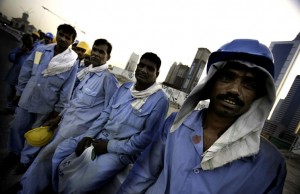In this blog post, Sanjay Khan Chowdhury, who is currently practising under a Senior Advocate in Calcutta High Court and is also pursuing a Diploma in Entrepreneurship Administration and Business Laws from NUJS, Kolkata, explains how labour legislation can promote the Make in India scheme.
In the year 2015, India stood at 142 as against 182 on ease of doing business along with its labour laws, which make nothing for doing business. After a long echo for labour reforms, it gathered momentum initiated by make in India and ease of doing business. The Indian government desperately needed to reform their labour law, which was seen as a big hindrance to its economic growth and find its utility null and void in growing space of time. It was time that the government bring a globe of change in its labour laws to accelerate business and address new issues to labour sector. It was also time that India learnt to do what its closest competitor China is doing.  Indeed, to compete with China was seen as an uphill task and massive changes where needed to compete with its closest competitor and neighbour. In India, currently, there are more than 400 labour laws for central and state combined. Thus, the problem of labour laws needs close and deep introspection. It has also been accused many times that these laws neither has any benefit nor strength for working for population and at the end, they better serve the employer rather than employees. In desperate need for reforms, there are several changes that the government of India needs to inculcate if it wants to really change the domain of its manufacturing sector.
Indeed, to compete with China was seen as an uphill task and massive changes where needed to compete with its closest competitor and neighbour. In India, currently, there are more than 400 labour laws for central and state combined. Thus, the problem of labour laws needs close and deep introspection. It has also been accused many times that these laws neither has any benefit nor strength for working for population and at the end, they better serve the employer rather than employees. In desperate need for reforms, there are several changes that the government of India needs to inculcate if it wants to really change the domain of its manufacturing sector.
What reforms can the current government bring to change the present scenario of Indian industries? The task is tough but not impossible to achieve the goal of global manufacturing hub. The changes that are urgently and immediately needed are divided into seven parts.
Uniform labour laws
At present- there are around 400 local and national laws prevailing throughout the country. Around 26 crores more or less population is involved in agriculture and around 10 crores are involved in the unorganized sector like construction and retailing. Interestingly none of them are fully covered under the prevailing labour laws. Out of 9 crore workers in the organised sector, only 3 crores including public and private sector combined together are covered by existing law as per the data provided by R.B.I. It’s a very depressing figure for a country whose population is skyrocketing at around 120 crores. India has a lot of sector-specific law which makes lots of overlapping problems and issues which needed to be addressed at the earliest. As a result of such sector-specific law, many companies tend to hire employees on a temporary basis rather than permanent. Some of that laws are payment of wages (Air Transport Services) Rules 1968, Sales Promotion Employees (Condition of Service) Act 1976” etc.
Compound existing law that have a common Application and Objective
The Government should rationalise the prevailing labour law, which has common application and objective. For example, according to prevailing labour law, a labourer in the state of Tamil Nadu under Minimum Wages Act is entitled to Rs. 346.20 per day (laundry and washing clothes) and a labourer in the state of West Bengal is entitled to Rs 245 per day In the fountain and ball point industry, yet we all know how much they are paid. Indeed, they are paid a needle as compared to their sanctioned wages.  The Government should draw a uniform way of payment of wages of labourers throughout the country keeping in mind the living standard and inflation. This would save up lots of resource of the government and in a way, could bring about awareness among the labourer of the country. The Act covering various facets of the society like child labour, maternity benefits, bonded labour can all be clubbed together as one single Act since they all intend to achieve a single objective. These Multiple Oceans of law deprived the employer in seeking employees in turn they hesitate and out of a problematic situation of legal compliance they end up depriving the economics of scale.
The Government should draw a uniform way of payment of wages of labourers throughout the country keeping in mind the living standard and inflation. This would save up lots of resource of the government and in a way, could bring about awareness among the labourer of the country. The Act covering various facets of the society like child labour, maternity benefits, bonded labour can all be clubbed together as one single Act since they all intend to achieve a single objective. These Multiple Oceans of law deprived the employer in seeking employees in turn they hesitate and out of a problematic situation of legal compliance they end up depriving the economics of scale.
Relax Retrenchment of Labour
This is one most politically charge up problem backed by left and allied group who call them as the protector of working class (bourgeoisie and the proletariat Marxism theory). But Interestingly it only tends to and is supported by mere 3 crores of working for the population in the country out of 120 crores which seem laughable and nonsense. In my firm, most opinions neither as socialist nor as a capitalist liberalise retrenchment can be the single, most dominant reform that can withstand nuclear blast India prospect of global Manufacturer.
Employees of the Rolls-What!
The government in the past have been unsuccessful in monitoring labour compliance by the employer to the industry in organised Sectors, forget about the unorganized sector. According to the existing law, employers are responsible for maintaining Labour compliance and also labour who are in contract with them. It’s when the employees added additional labour through contract when labours went down. Thus, the employer appoints contractors who in turn provide them with contract labour which in turn pay them much less as what sanctioned by law since they do not fall under the prevailing labour laws on Rolls. Even with that, the Employers appoint Contract Labour for a shorter duration for fear of legal compliance leading to further miniaturisation. The simple solution would be that of providing compliance standard simplified.
Education Cum training and Redevelopment
This is a genuine issue which the Industrial Dispute Act has horribly failed to address. As the Godfather of all the labour laws which are the Industrial Dispute Act 1947, its basic crux is to prevent indiscriminate Hiring and firing. The Industrial Dispute Act has caused serious issue of economic and socio strata. They make the running of industries and its expand very difficult. Thus, large scale industries for example Jute Industry in West Bengal has been totally wiped out by lockouts and bankruptcy of the companies eventually dying out. The labour should be provided with adequate training as in the case of retrenchment or firing, they can be transferred or job ready for another work.  The labourer should be provided with the imparting technical vocational skill to the labour and that in the case of retrenchment they can be successfully placed somewhere else. The best way to function would be to create an independent body like worker welfare and education on pan India basis comprising of Intellectual, Academia, Technician, etc. And the existing body like National Productivity Council Employment which in my opinion belong to stone age should immediately be disbanded and thrown in the garbage. Yet it’s not easy but not impossible as well.
The labourer should be provided with the imparting technical vocational skill to the labour and that in the case of retrenchment they can be successfully placed somewhere else. The best way to function would be to create an independent body like worker welfare and education on pan India basis comprising of Intellectual, Academia, Technician, etc. And the existing body like National Productivity Council Employment which in my opinion belong to stone age should immediately be disbanded and thrown in the garbage. Yet it’s not easy but not impossible as well.
Create a New Transparent and efficient Dispute resolution mechanism
At present disputes of the employees take lots of time and are full of legal hassle. The present Industrial Dispute and its procedure are of Stone Age loaded with work and are inadequate to handle today modern dispute. Thus, there is urgent need to reform the Industrial Dispute Act way of Labour issue to effective resolution and time bound disposal of issues. I would suggest that Arbitration would be of immense help if it is applied. It can be very fast and purposeful in applicability and well suited to the present-day environment. The government should also try to bring awareness among the labourer of their right and duties through its efforts.
Exclusion with Compensation
The labours in India is unsecured and are not eligible for compensation after expulsion. Its seems after so many years of Independence still the government of the country lacks behind in the fundamental issue of governance in the country. The stability and economics of the labour in India is still a problematic issue whereas a worker in Maruti manufacturing enjoys a benefit of Compensation where a person working under IT with one-third does not so. Some of the Labour Laws were implemented in the country on the basis of our Socialist belief, but it seems that instead of being helpful to the labour community its null and void in its applicability. The depressing part is that we claim of the global power cum developed nation yet we fail in providing basic fundamental issue concerning the majority of the country.
The best example to India would be that of China where it has strengthened its labour after 2007, providing both improved condition and rights of their citizens. The changes are coming through states like Rajasthan, which has brought an overhaul of it labour laws and showing the way. According to Rajasthan labour law (New), an Industrial establishment employing about 300 workers can retrench its employees without seeking government approval. The threshold of the number of employees for the purpose of Factories Act has been increased from 10-20 (in electricity powered) and from (20-40 in without power). Thus this will certainly lower red tapism and paperwork related issues in small units. Thus, the central government should learn from its states on amending their archaic laws. China with its flexible and adaptive business and labour laws where the investor finds India rigid and restrictive. India’s participation at the World Trade Organization is sad with no keen interest or enthusiasm as if it maintains an anti-WTO stand losing its number 1 position. Trillion dollars in 2014 with little scope anytime soon with the European Union or Trans-Pacific Partnership agreement. The pending goods and service tax (GST) can also be helpful in providing a climate for boosting Economy and Manufacturing sector in the country. Yet the task for the global giant in manufacturing seems bleak but through reformed law and right attitude India can write a marvellous history and can change the course of its own path.
 Serato DJ Crack 2025Serato DJ PRO Crack
Serato DJ Crack 2025Serato DJ PRO Crack









 Allow notifications
Allow notifications



